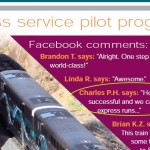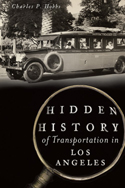As “Carmageddon” (the closure of I-405 in the Sepulveda Pass) fades into history for the next eleven months, let us now discuss the history of bus services between West Los Angeles and the San Fernando Valley
Between the Westside and the Valley – Before the I-405
Before there was a road in the Sepulveda Pass, travelers in Santa Monica or West Los Angeles who wished to get to the San Fernando Valley had to take a circuitous route via one of the other mountain passes. The Cahuenga Pass, which had both roads and rail, was the most likely choice; other passageways included Laurel Canyon, Beverly Glen and Topanga Canyon.
Between 1929 and 1934, Bay Cities Transit (a forerunner to Santa Monica’s Blue Bus) operated a bus route through the mountains via Beverly Glen Bl. Sepulveda Bl. through the Pass opened in 1935; by mid-1936, Lomita-based Motor Coach Company extended its Long Beach-Santa Monica route via Sepulveda Bl. through the Pass and into Van Nuys and San Fernando. Motor Coach was absorbed by Greyhound in 1940; the Santa Monica-San Fernando portion of the route was abandoned sometime in the mid-50s.
I-405
Over time, Sepulveda Bl. clogged with traffic. More lanes (at least in the opinion of highway engineers) were desperately needed. Construction began on the portion of I-405 (San Diego Freeway) through the Sepulveda Pass in 1960; by 1962, the freeway opened to traffic. However, transit bus service through the Pass was still a few years away.
RTD’s Freeway Flyer
In May 1967, RTD implemented new Line #88. This service started in the center of the San Fernando Valley at Van Nuys Bl. and Sherman Way, continuing south along Van Nuys to Ventura Bl, then onto I-405 to UCLA and Westwood. Service operated Monday through Saturday.
#88 was extended further south along I-405 to Westchester, using Sepulveda to LAX, in November 1968. To “protect” the Culver City #3 along Sepulveda Blvd, there were boarding/alighting restrictions on #88; these were removed in August 1973.
1976 brought a number of improvements to #88. RTD added Sunday service in January, service to the Fox Hills Mall in May, and a substantial realignment at LAX in June. #88 (along with 12 other RTD routes) were kicked out of the LAX terminal loop and ended at 88th/Vicksburg. An RTD-operated shuttle (#206) connected these lines to the airport terminals. SCRTD extended #560 northward to Lakeview Terrace in January 1977, replacing former line #157.
In 1983’s “Great Renumbering,” #88 became #560. 1984 was the year that LAX’s City Bus Center at 98th St near Sepulveda opened, and all transit buses were routed into the new facility. LAX shuttle buses replaced RTD’s #206 airport terminal shuttle service.
Imperial Terminal service
Imperial Terminal, south of LAX’s main terminals, was mostly for freight and charters, although a few scheduled services such as MGM Grand Air also used it. #88/560 served Imperial Terminal between 1981 and 1987. This was mostly late at night when other buses serving Imperial Terminal provided little service.
Out of One, Two
In 1995, bus service in the San Fernando Valley underwent an extensive restructuring. #560 was replaced by two new lines. #233 operated local service along the Van Nuys Bl-Lakewood Terrace route, while #561 followed the #560 route from LAX and Westwood via I-405 to Ventura Bl. Then served limited stops along Van Nuys Bl between Ventura Bl. and San Fernando Road. Then, #561 operated along San Fernando Road to the Sylmar Metrolink station. Late at night, when neither limited stop service on Van Nuys Bl nor additional service to Sylmar was warranted, #561 through-routed with #233 at Ventura Bl. When the Metro Green Line opened in August, #561 was extended to serve the Aviation/I-105 station. Similarly, the opening of the new Getty Museum along the I-405 in 1996 was cause for rerouting the #561 to serve that facility, although the reroute put more bus travel along Sepulveda Bl, and off the freeway.
Traffic continued to worsen on I-405, causing buses to run slower and later. It was not uncommon for a passenger aboard a #561 stuck in traffic to see a Culver City #6 zooming by on Sepulveda Bl. Therefore, in 2003, when LACMTA reconfigured #561 into Rapid Bus #761, the service south of Westwood was dropped. MTA hoped that Culver City would soon operate a rapid bus along Sepulveda Bl, replacing this portion of #561. Culver City did implement a Rapid—in January 2010.
Due to a construction (freeway widening) project in 2005 LACMTA moved the northbound #761 off the freeway and onto Sepulveda Bl. This detour became permanent in 2006.
Other services
Flyaway buses between Van Nuys Airport and LAX have been operating since the mid 1970s. An additional Flyaway route from Westwood operated briefly in the 1980s, and was reinstated in the early 2000s.
In the 1970s, 80s and early 90s, private buspools used the I-405 to connect commuters living in the San Fernando, Santa Clarita or Antelope Valleys with aerospace plants in El Segundo and Orange County.
LADOT Commuter Express started operating two new routes in 1993. #573 runs from the San Fernando Valley (Balboa Ave) to Westwood and Century City. #574 uses a similar route in the Valley, but ends in El Segundo.
After the 1994 Northridge Earthquake, transit agencies in Santa Clarita and the Antelope Valley started providing service along the I-405 corridor to the San Fernando Valley, Westwood and El Segundo. Many (but not all) of these services survived to the present day.
Sources:
Anton, Mike. “405 Freeway’s path tells a story of near-constant change.” Los Angeles Times, July 14, 2011
http://map.ais.ucla.edu/go/1004537 (Culver City Rapid)
“Bus Service Franchise is Applied For” Van Nuys News, August 23, 1929 (Bay Cities Transit service from West Los Angeles to Van Nuys via Beverly Glen)
“Taps for University Buses” Van Nuys News, July 16, 1934
“Approve Bus Line, Valley to Beaches” Van Nuys News, June 18, 1936
Husing, Jim. “Greyhound’s Santa Monica-Long Beach Commute Service.” NorCal Express, Winter 2010.
“New Motor Coach Line Operating” Van Nuys News, July 16, 1936
http://www.transit-insider.org/ (history of bus service in San Fernando Valley)



Recent Comments